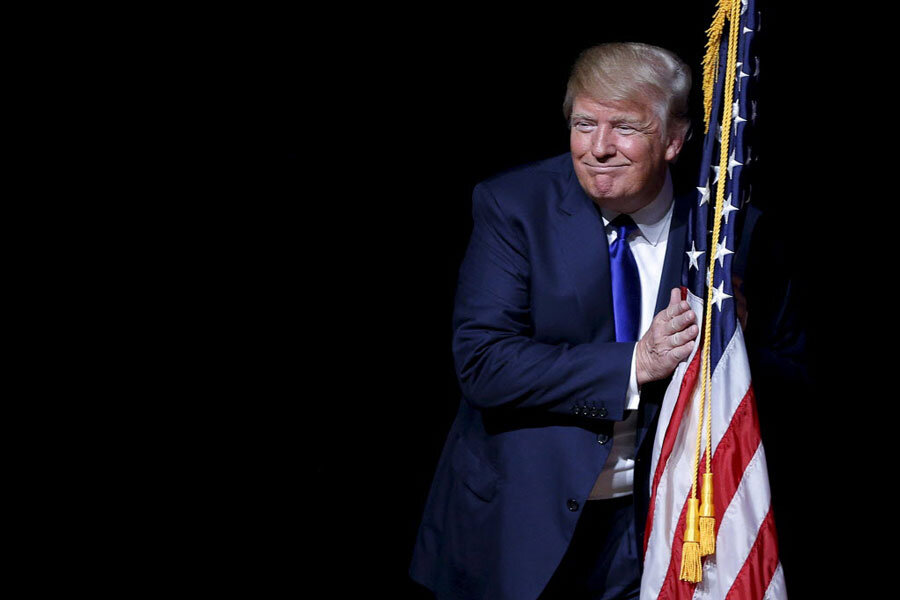Finding balance in the politics of fear
Loading...
In the aftermath of terrorist attacks in Paris and Mali, there’s a new emotion permeating United States politics: fear.
Scenes of devastation overseas have caused concerns about strikes on US soil to rise sharply among American voters. In a recent Washington Post/ABC News poll, 83 percent of respondents agreed that a deadly attack is likely in America in the near future – a spike of about 10 points from previous similar surveys.
Republican presidential candidates have been quick to address – opponents use the word “exploit” – this spreading worry. Most call for a halt to US acceptance of Syrian refugees, lest a terrorist among them sneak into the country. Some – notably Donald Trump – have gone farther in identifying Muslims as frightening, dangerous others.
Mr. Trump has endorsed the reintroduction of waterboarding as a terror suspect interrogation technique. He’s talked about putting mosques under surveillance and seemed at one point to endorse a US Muslim registry.
Trump insisted he saw thousands of Muslims celebrating in New Jersey after the 9/11 attacks. Numerous journalistic investigations of this charge have found no evidence such an incident ever occurred.
Amid this roiling emotion, it may be useful to remember that the aim of terrorism is to provoke just such fearful reactions, and that an average American is more at risk from falling furniture than terrorist attacks.
In addition, measures of violence of all kinds, from wars to homicides to child abuse, are decreasing, as Harvard cognitive science professor Steven Pinker documented in his 2011 book, “The Better Angels of Our Nature.”
The Islamic State remains a brutal group that must be countered with military force – perhaps more concerted force than the US has used so far.
“Still, we must not lose sight of the fact that though some violent fanatics may stand athwart the trend towards greater peace and tolerance, violence is slowly retreating,” writes Chelsea German of Human Progress, a group dedicated to publicizing the gap between the reality and the perception of many measures of world well-being.
The Obama administration may not have helped the national mood with its initial responses to increased fear and demonization of Muslims in general.
President Obama perhaps stooped to the level of his critics when complaining last week that the Republican politicians who oppose continued resettling of Syrian refugees in the US are “scared of widows and orphans.”
He was indirectly referring to a remark from presidential hopeful and New Jersey Gov. Chris Christie, who has said he would not allow Syrian “orphans under five” into his state.
Even some members of the president’s party complained that his remarks seemed a bit petulant and out of touch with the natural response of Americans to the horrific attacks of recent days.
“I think we needed to hear amore forceful statement about the barbarity of these attacks and the fact that America is committed to destroying and eradicating ISIL,” said Sen. Mark Warner (D) of Virginia, using an acronym for in a Monday interview with Andrea Mitchell of NBC.
Terrorism is terrifying, after all. That’s what its perpetrators aim for. It has certain inherent aspects that can cause the rest of us to miscalculate its danger to us, according to Andrew Shaver, a doctoral candidate in public policy at Princeton University in New Jersey.
For one thing, it strikes unexpectedly. It appears out of our control. Humans feel more vulnerable when confronted with dangers they can’t influence – they are more worried about airplane crashes than auto accidents, for instance, even though the latter cause many more fatalities.
Terrorism also inspires dread, and can affect large numbers of people per incident.
“Islamist terrorism has all three of these characteristics, inspiring excessive fear – surely by design,” writes Shaver in a post on the Washington Post’s Monkey Cage political science blog.
Yet since the 9/11 attacks, Americans have been no more at risk from terrorism than from being crushed by unstable televisions and other furniture, Shaver points out.
So what’s the middle ground? Can politicians strike some sort of balance between fact-challenged fear mongering on the one side, and a more dismissive low-key response on the other?
The need will be to produce more action in fighting the Islamic State abroad while avoiding the abrogation of America civil liberties – or its heritage of helping the downtrodden – at home.
Mr. Obama made a start on the former on Tuesday during an hour-long White House press conference with French President François Hollande.
The appearance seemed an obvious and deliberate show of unity with a French political ally whom even Republicans have praised for a forceful response to IS terror.
“We cannot and we will not succumb to fear,” Obama said, standing next to Mr. Hollande. “Make no mistake, we will win, and groups like ISIL will lose.”
As for the harsh rhetoric against Muslims, Trump on Tuesday dialed back his words, but only a bit. Instead of claiming he’d seen “thousands” celebrating the fall of the Twin Towers, he said at an Ohio rally that he’d seen or read on the Internet about “fairly large” numbers of such celebrants.
Then he crowed about his poll numbers, as he continues to lead the GOP pack. He mocked Ohio governor and fellow presidential hopeful John Kasich. In the past, Governor Kasich has been to the left of Trump on immigration, but in recent weeks he’s shifted right and now says Ohio shouldn’t take any more Syrian refugees.
“I heard he’s dropping out,” Trump said.
Almost half of all GOP voters share Trump’s views that Syrian refugees should be barred, and all illegal immigrants in the US deported, according to Washington Post/ABC News data. How far will such support take him? What will be its magnetic effect on the rest of the Republican pack?
The answers to those questions could determine the role that fear plays in US politics in 2016, and perhaps beyond.






